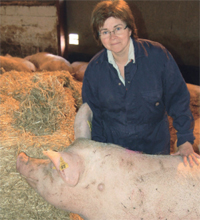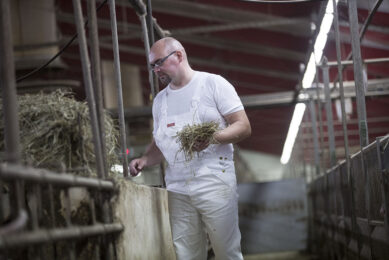The Two-Tonne Sow: Britain’s aim to reacht he EU level

An ambitious project to dramatically increase the production of pig meat is rapidly taking shape in Britain, where a growing number of producers are climbing aboard what has been loosely defined as the ‘Two-Tonne Sow’, or 2TS.
The aim of this innovative three-year programme is to lift the UK industry’s average production from its present ‘disappointing’ 1,608 kg of pig meat per sow per year at the bottom of the EU’s rankings up to at least the current EU average of 2,000 kg per pig per sow per year.
Dreamt up by the technical and marketing teams at the British Pig Executive (BPEX), the 2TS campaign is also geared to ensure that British producers – and the industry as a whole – are in a position to maintain their competitiveness in the global market.
“This is an extremely important target for us,” says Dr Mike Varley, head of knowledge transfer, research and development, at BPEX.“We are currently lagging behind countries like Ireland, which has an annual industry average of 1,789 kg/ sow/ year, and Germany (1,993 kg/ sow/ year), while France, Denmark and the Netherlands top 2,000 kg a year. Closing this performance gap is crucial to ensure the long-term competitiveness of the English pig sector. Producers here must do something soon to ensure they are in a strong position to sustain profitability even when the market place and exchange rates are less favourable.”
Performance and sustainability
Varley says the programme, which was launched in the spring in 2010, had been specially designed to improve the financial performance and sustainability of every English herd, as well as increase production while at the same time reduce the sector’s environmental impact on the land.
“It’s all about improving performance at all stages of productivity from litters per sow per year and the number born alive through to litter variation, mortality, growth rate and slaughter weight, as well as health. But, most importantly, it calls for commitment and attention to detail,” he says. Recognising that there is a variety of production systems in operation across the country, the campaign has been broken down into six bite-sized chunks, each one focusing on a particular area so that everybody can participate in the national effort. These six ‘pillars’ are:SBlt Breeding SBlt NutritionSBlt Health SBlt FinishingSBlt Buildings SBlt Staff training
Management
Kicking off with gilt management and reproduction management this year, a series of national, regional and local seminars, workshops and training courses featuring international experts like Wageningen University & Research Centre scientific director Prof Bas Kemp and his colleague Dr Nicoline Soede, took a closer look at the latest breeding management systems that could help the UK producers get larger litters and an increased number of piglets weaned.
They focused on providing UK producers with latest tips on gilt management, and reproduction, with a closer look at genetics, insemination techniques, AI technology, and how to establish pregnancy, as well as farrowing and caring for piglets, while also outlining some of the challenges they could face – such as second litter drop syndrome and stress.
A similar approach will be taken with the other five ‘pillars’ over the next two years, with video footage, as well as PowerPoint presentation from the national conferences being taken around the country to regional pig discussion groups to ensure that even the smallest local group of producers get the full benefits of the 2TS message.
In an effort to involve as many producers as possible, BPEX has also developed a sow productivity calculator to allow them to work out where their herd’s physical performance currently stands as far as pig meat per sow per year stands. Available online at www.2TS.org.uk, this management tool will automatically calculate annual output from a small number of key performance figures.
Concerted action
It is believed that this concerted action, which will be spread over the three years of the multi-million pound project, will get everybody – including the allied industries, which are seen as having a key role in helping producers achieve this task – involved and motivated to think about performance.
It will also offer the producers all the latest facts and figures on how they can obtain more from their pigs, as well as important international benchmarks to encourage them to move forward.
“It’s the most important thing we have to do today,” says Andrew Knowles, chief of communications and supply chain development at the Warwickshire-based BPEX offices. “It’s essential that we increase production to allow us to remain competitive in Europe, let alone in the world market these days.”
Hitting the target
And it is not an impossible target for UK producers; some of them, including Lincolnshire producer Meryl Ward, who has 2,200 sows and is finishing most of them for bacon, are already hitting the 2,000 kg/ sow/ year target in some of their herds.
Ward explains that sows in one herd are already achieving an average of 13 piglets born alive per litter and “if you take them all through to 110 kg liveweight, you can do the maths yourself and see that we are topping the 2,000 kg of pig meat per sow per year already,” she says.
Ward, who recently received the UK pig industry’s prestigious David Black Award for her ‘significant and sustained contribution’ to the sector, puts her production success down to a combination of factors, including genetic potential, nutrition, good management and, above all, attention to detail.She explains that she has her own in-house breeding programme and works closely with her breeding company to obtain specific dam line boars to help her improve the prolificacy of the sows and the gilts to ensure high performance.“We also pay particular attention to health and welfare to ensure we get healthy piglets that we can take through to 110 kg liveweight. I don’t think one should just concentrate on trying to achieve bigger litters. It is more important to make sure you are able to wean all the piglets that are born and that you can then take those animals through to finishing at a good weight. You do need good genetics to do this, but you also need to ensure good nutrition and good management.”
“It’s all about increasing the number of piglets born alive and taken all the way through to finishing,” she says. I am sure other producers can do the same, if they focus their efforts on the BPEX target and follow the advice the organisation is providing over the course of the 2TS campaign.”
Processors
Ward has also called upon the British processors to play their part. “They need to gear up so that they can deal with heavier pigs. We have to get away from just producing pigs to suit certain supermarkets.”
BPEX chairman Stewart Houston, who is also executive director of the country’s National Pig Association, says it is important that as many producers as possible get involved with the 2TS campaign because “we have to catch up with producers in other EU countries.
“It’s not just about the number of piglets per litter, but more about growing those piglets efficiently and paying attention to detail so we can increase output – and here the whole industry can help us, especially the feed companies,” he says.Speaking during his visit to the UK, Prof Kemp was full of praise for the campaign, saying he was pleased it was looking at pig production all the way through to finishing pigs and suggested similar campaigns could be useful for producers in other parts of the EU.











